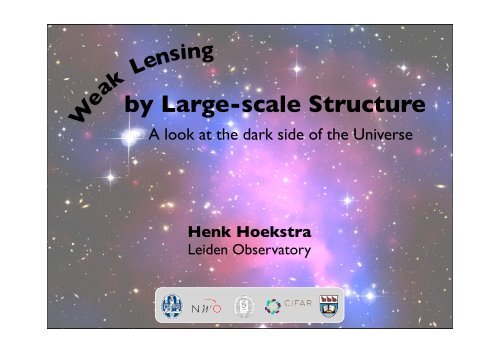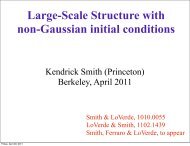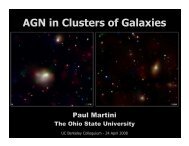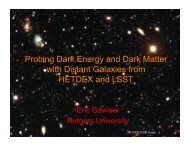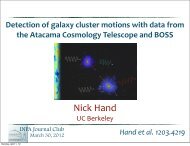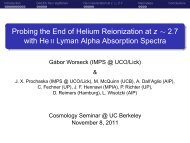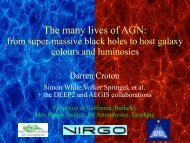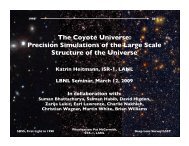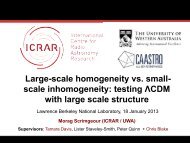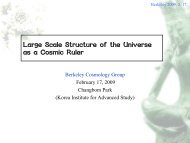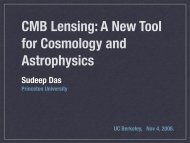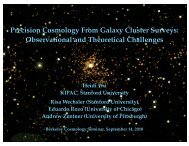Weak lensing by large scale structure
Weak lensing by large scale structure
Weak lensing by large scale structure
You also want an ePaper? Increase the reach of your titles
YUMPU automatically turns print PDFs into web optimized ePapers that Google loves.
We<br />
ak<br />
Lens<br />
ing<br />
<strong>by</strong> Large-<strong>scale</strong> Structure<br />
A look at the dark side of the Universe<br />
Henk Hoekstra<br />
Leiden Observatory
What is dark energy?<br />
The hardest thing of all is to find a black cat in a dark room,<br />
especially if there is no cat - Confucius<br />
Is it a cosmological constant or a dynamic field?<br />
Or is there a problem with General Relativity?<br />
We lack a theoretical framework that can explain<br />
the observations. Observational constraints are<br />
needed to make progress.
How to proceed?<br />
We have a number of probes at our disposal, each<br />
with their own advantages and disadvantages.<br />
Distances:<br />
- standard candles (type Ia SNe)<br />
- standard rulers (CMB, BAO)<br />
Growth of <strong>structure</strong>:<br />
- counting galaxy clusters<br />
- clustering of matter<br />
expansion history only<br />
expansion history<br />
+<br />
modified gravity
z=3<br />
z=1<br />
z=0<br />
Spot the difference...<br />
ΛCDM OCDM<br />
Different values for cosmological<br />
parameters lead to a different<br />
distribution of (dark) matter and a<br />
different evolution.<br />
The clustering properties of matter as a<br />
function of <strong>scale</strong> and redshift can be used<br />
as a tool to measure the cosmology!<br />
Kauffmann et al.
Look at the bright side?<br />
We can simulate the dark matter distribution<br />
quite well, but unfortunately that is not what<br />
we can observe...<br />
Can we use the observed distribution<br />
of galaxies instead? Or predict the<br />
distribution of galaxies for a given set<br />
of cosmological parameters?
Light ≠ Density!
Simulating the Universe<br />
GIF simulations, Colberg et al.<br />
Example of the galaxy<br />
distribution based on semianalytic<br />
models.<br />
Need to include:<br />
Star formation<br />
SNe feedback<br />
Chemical enrichment<br />
Gas infall<br />
Merger history
Use the force...<br />
“For my ally is the force, and a powerful ally it is” - Yoda
Gravitational <strong>lensing</strong><br />
As predicted in the early 20 th century, rays of light are deflected<br />
<strong>by</strong> massive objects in the universe.<br />
The angle of deflection is a direct measure of mass!
Gravitational <strong>lensing</strong><br />
Inhomogeneities in the mass distribution distort the paths of<br />
light rays, resulting in a remapping of the sky. This can lead to<br />
spectacular <strong>lensing</strong> examples…
Gravitational <strong>lensing</strong>
Gravitational <strong>lensing</strong><br />
Rich strong <strong>lensing</strong><br />
cluster from RCS2<br />
at z=0.7
Gravitational <strong>lensing</strong><br />
Strong gravitational <strong>lensing</strong> requires a good alignment of the source<br />
and the lens. This doesn’t happen often...<br />
The light rays of all objects are perturbed, but the effect is<br />
usually just too subtle to see:<br />
an (unknown) shift in position<br />
a small distortion of the shapes of the galaxies
<strong>Weak</strong> gravitational <strong>lensing</strong><br />
A measurement of the ellipticity of a galaxy provides an<br />
unbiased but noisy measurement of the shear
<strong>Weak</strong> gravitational <strong>lensing</strong><br />
Credit: Michael Sachs<br />
Cluster<br />
In the absence of noise we would be able to map the matter<br />
distribution in the universe (even “dark” clusters).
We can see dark matter!<br />
... and it’s blue!<br />
Clowe et al. (2006) Mahdavi et al. (2008)
<strong>Weak</strong> <strong>lensing</strong> mass calibration<br />
Observations Masses Simulations<br />
<strong>Weak</strong> <strong>lensing</strong> masses<br />
A <strong>large</strong> sample of clusters with accurate weak <strong>lensing</strong><br />
masses is important for the success of cluster abundance<br />
studies.
<strong>Weak</strong> <strong>lensing</strong> mass calibration
Hoekstra et al. (submitted)<br />
Quantifying scatter
X-ray mass<br />
Lensing vs X-ray masses<br />
Δ= 2500 Δ= 500<br />
<strong>lensing</strong> mass<br />
Mahdavi et al. (2008): at <strong>large</strong> radii the gas is not in<br />
hydrostatic equilibrium.
Cosmic shear is everywhere<br />
Credit: Tyson et al. (2000)<br />
Cosmic shear is the <strong>lensing</strong> of distant galaxies <strong>by</strong> the overall<br />
distribution of matter in the universe: it is the most “common”<br />
<strong>lensing</strong> phenomenon.
An ideal probe of cosmology?<br />
<strong>Weak</strong> <strong>lensing</strong> provides a direct measurement of<br />
what we want: the (projected) matter distribution<br />
The physics is well understood: General Relativity<br />
The applications are numerous.<br />
statistical properties of the matter (cosmological parameters).<br />
relation between galaxies and dark matter (galaxy biasing).<br />
properties of dark matter halos (test of CDM and law of gravity).
Why cosmic shear?<br />
Current observational constraints on the properties<br />
of dark energy are crude at best. Progress depends<br />
critically on how well various cosmological probes<br />
can be understood:<br />
Do we understand what we are doing?<br />
DETF comments: “The WL technique is also an emerging technique. Its<br />
eventual accuracy will also be limited <strong>by</strong> systematic errors that are difficult<br />
to predict. If the systematic errors are at or below the level asserted <strong>by</strong><br />
the proponents, it is likely to be the most powerful individual Stage-IV<br />
technique and also the most powerful component in a multi-technique<br />
program.”
Averaged shape:<br />
Do we understand?<br />
The underlying assumption is that the position angles are random<br />
in the absence of <strong>lensing</strong>. At some level intrinsic alignments will<br />
complicate things (can be dealt with using photometric redshifts).<br />
no <strong>lensing</strong> <strong>lensing</strong>
What do we need to do?<br />
We only need to measure :<br />
- shapes<br />
- redshifts<br />
The background (or source) galaxies are typically very<br />
faint and spectroscopic redshifts cannot be obtained.<br />
Even determining photometric redshifts can be difficult.
What do we need to do?<br />
GREAT’08 challenge<br />
Measure the shapes of objects like this?
What do we need to do?<br />
The weak <strong>lensing</strong> signal is small:<br />
We need to measure the shapes of many galaxies.<br />
We need to remove systematic signals at a high level of accuracy.<br />
Only recently we have been able to overcome both obstacles,<br />
although we still need various improvements to deal with the<br />
next generation of surveys.
Build a big camera ...<br />
Megacam:<br />
1 square degree field of view<br />
~350 megapixels
... put it on a good telescope ...<br />
Such as the CFHT<br />
or VST, Subaru SNAP, etc
... and take a lot of data<br />
CFHT:<br />
CFHTLS<br />
RCS2<br />
CCCP<br />
MENeaCS<br />
VST:<br />
KIDS<br />
That’s when the fun starts!
Systematics<br />
The observational distortions are typically <strong>large</strong>r than the<br />
<strong>lensing</strong> signal.<br />
The observed shapes of galaxies need to be corrected for<br />
PSF anisotropy<br />
Circularisation <strong>by</strong> seeing<br />
Camera shear<br />
Various correction techniques have been developed and tested extensively. In<br />
particular the Kaiser et al. (1995) approach is widely used. This method works<br />
fine for current data sets, but we need improved methods for upcoming <strong>large</strong><br />
surveys.
Dealing with systematics<br />
<strong>Weak</strong> <strong>lensing</strong> is rather unique in the sense that we can<br />
study (PSF-related) systematics very well.<br />
Several diagnostic tools can be used. However, knowing<br />
systematics are present doesn’t mean we know how to<br />
deal with them…<br />
But we can readily simulate weak <strong>lensing</strong> surveys. The<br />
Shear TEsting Programme (STEP) and the GREAT’08<br />
challenge are aiming to improve our techniques this way.
E-mode (curl-free)<br />
B-mode (curl)<br />
Diagnostics<br />
The <strong>lensing</strong> signal should be curl-free. We can project the correlation<br />
functions into one that measures the divergence and one that measures the<br />
curl: E-B mode decomposition. We can also look for correlations between the<br />
corrected galaxy shapes and the PSF anisotropy.
Simulations<br />
It is relatively easy to create simulated data to test the<br />
measurement techniques.<br />
The Shear TEsting Programme is an international collaboration to<br />
provide a means to benchmark the various methods. This has<br />
evolved into a challenge to involve computer scientists: GREAT’08<br />
?
Simulations<br />
So far two papers have been published (Heymans et al., 2006<br />
and Massey et al., 2007). These results provide a snapshot of<br />
the current accuracy that can be reached (~1-2%).<br />
PSF anisotropy<br />
Correction for PSF size
What does the signal mean?<br />
non-linear physics<br />
The matter power spectrum (analogous to the that of the CMB)<br />
is one way to represent the measurements.
What does the signal mean?<br />
The cosmic shear signal is mainly a measurement of<br />
the variance in the density fluctuations.<br />
Same “<strong>lensing</strong>” signal<br />
Little bit of matter, <strong>large</strong> fluctuations<br />
Lot of matter, small fluctuations<br />
To first order <strong>lensing</strong> measures a combination of the amount of<br />
matter Ω m and the normalisation of the power spectrum σ 8.
What does the signal mean?<br />
We can break this degeneracy <strong>by</strong> measuring the<br />
<strong>lensing</strong> signal as a function of source redshift.
Results: a decade ago...<br />
This page was left blank intentionally…
Results: status in 2002<br />
Since the first detections reported in spring 2000, several<br />
cosmic shear measurements have been published.<br />
Refregier (2003)
Results: status in 2003<br />
CMB<br />
Lensing<br />
Van Waerbeke & Mellier (2003)
CFHT Legacy Survey<br />
The Canada-France-Hawaii Telescope Legacy Survey is a five year<br />
project, with three major components. Observations were completed<br />
in the 2008B semester.<br />
The Wide Survey focuses on weak <strong>lensing</strong>.<br />
• ~140 square degrees<br />
• 4 fields<br />
• 5 filters (u,g,r,i,z’)<br />
• i
CFHTLS: first results<br />
~20 square degree used in Hoekstra et al. (2006)
CFHTLS: first results<br />
We think the observed <strong>lensing</strong> signal is fairly accurate.<br />
But how about the interpretation. Do we know?<br />
Were getting there!<br />
The early results were based on the HDF photometric<br />
redshift distribution. The redshift distribution obtained <strong>by</strong><br />
Ilbert et al. (2006) based on CFHTLS Deep data suggests a<br />
higher mean redshift!
CFHTLS: first results<br />
Since the publication of the first results a number of<br />
things have improved:<br />
Reduced systematics<br />
Larger area observed (we can probe <strong>large</strong>r <strong>scale</strong>s)<br />
Improve estimates of cosmological parameters using photo-z’s<br />
The latest results, based on the analysis of 57 sq. deg. spread<br />
over 3 fields have recently been published in Fu et al. (2008)
CFHTLS: recent results<br />
Measurements out to 4 degree <strong>scale</strong>s!
CFHTLS: recent results<br />
Cosmology is “<strong>scale</strong> independent”: non-linear corrections sufficient so far.
CFHTLS: recent results<br />
Results agree well with WMAP3 (and WMAP5…)
CFHTLS: what is next?<br />
Currently ~140 sq. deg. of data have the full ugriz coverage<br />
and photometric redshift have been determined.<br />
With photometric redshift information for the sources we can<br />
study the growth of <strong>structure</strong>, which significantly improves the<br />
sensitivity to cosmological parameters.
Hot of the press!<br />
Schrabback et al. (submitted): analysis of COSMOS
Tomography works!<br />
Redshift dependence is as expected in ΛCDM...
Tomography works!
Evidence for dark energy<br />
From COSMOS weak <strong>lensing</strong> analysis only
The devil is in the details...<br />
The accuracy of the first cosmic shear surveys is<br />
mostly limited <strong>by</strong> statistical noise (small areas).<br />
For the next generation many subtle effects need to<br />
be taken into account. This is already evident from<br />
our new COSMOS analysis.<br />
We are discovering these (and correcting these) as<br />
we go along…
Averaged shape:<br />
Do we understand?<br />
Are position angles random in the absence of <strong>lensing</strong>?<br />
No! There are intrinsic alignments<br />
no <strong>lensing</strong> <strong>lensing</strong>
Complications<br />
Intrinsic alignments complicate the cosmological<br />
interpretation of the <strong>lensing</strong> signal. CFHTLS and other<br />
surveys will allow us to measure the amplitude of the<br />
intrinsic alignments.<br />
Dealing with intrinsic alignments will benefit greatly from these<br />
photometric redshift data. Recent work suggests that the effect of intrinsic<br />
alignements can be corrected for to a sufficiently low level.
Further ahead...<br />
The study of dark energy is an important application<br />
of cosmic shear. The CFHTLS will provide the first<br />
constraints from a ground based survey. But a useful<br />
measurement of the dark energy parameters requires<br />
much better precision.<br />
The several hundred million dollar questions is:<br />
Can we reach percent precision from the<br />
ground of do we have to go to space?
Advantages of space<br />
SuperNova Acceleration Probe or JDEM?<br />
• much smaller PSF<br />
• optical + NIR bands<br />
• higher source density<br />
• higher source redshift<br />
• better photo-z’s<br />
• <strong>large</strong> reduction in systematics
Conclusions<br />
The CFHTLS weak <strong>lensing</strong> project is progressing well<br />
and is producing competitive cosmological results, but<br />
it is still work in progress.<br />
To achieve the full potential of the survey a number<br />
of issues remain...<br />
…but no show-stopper has been found!


